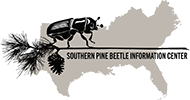Abstract
The southern pine beetle Dendroctonus frontalis Zimmermann (Coleoptera: Curculionidae: Scolytinae) is attracted to an aggregation pheromone that includes the multifunctional pheromone component endo-brevicomin. The effect of endo-brevicomin on attractive lures varies from strong enhancement to reduction of beetle attraction depending upon release rate, lure component spacing, and proximity of beetle infestations. Anecdotal observations have further suggested that the effects of endo-brevicomin vary during the year. We investigated this possibility under non-outbreak conditions in southwestern Mississippi where for two-and-a-half years we monitored traps baited with frontalin and the host odor alpha-pinene either (a) alone, or with an endo-brevicomin release device either (b) located directly on the trap, or (c) displaced 6m away. The endo-brevicomin devices in our tests increased D. frontalis catches during all times of year, and 6m displacement of the endo-brevicomin release device from the trap did not significantly alter responses except during the spring flight peak when displacement increased catches. Our data suggest that flying D. frontalis have a stronger tendency to avoid the immediate proximity of a release point of endo-brevicomin during their springtime dispersal flight when catches are greatest. Catches of Thanasimus dubius (F.) (Coleoptera: Cleridae), a major predator of D. frontalis, were not altered by endo-brevicomin, and ratios of D. frontalis to T. dubius changed over the course of the year. We discuss the possible effects of intra-annual variation in D. frontalis response to endo-brevicomin both on beetle attack behavior and use of endo-brevicomin as a lure adjuvant in D. frontalis population monitoring.
Keywords
monitoring, bark beetle, trapping, pheromone, phenology
To read the full article please visit the link below:
Sullivan, Brian T., Cavell Brownie, and JoAnne P. Barrett. 2016. “Intra-Annual Variation in Responses by Flying Southern Pine Beetles (Coleoptera: Curculionidae: Scolytinae) to Pheromone Component Endo-Brevicomin.” Journal of Economic Entomology 109 (4): 1720–28. https://doi.org/10.1093/jee/tow078.
